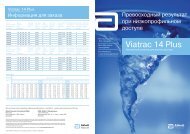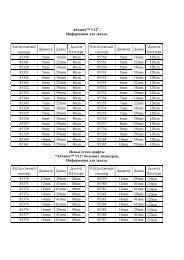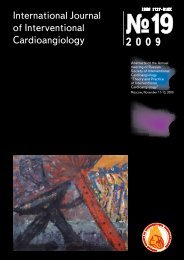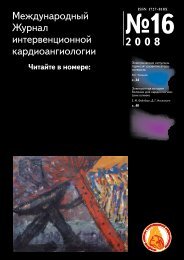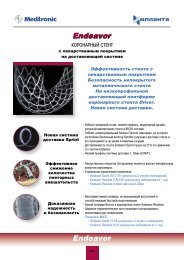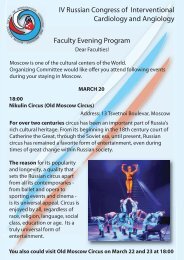Results of Coronary Stenting using the Stents with
Results of Coronary Stenting using the Stents with
Results of Coronary Stenting using the Stents with
You also want an ePaper? Increase the reach of your titles
YUMPU automatically turns print PDFs into web optimized ePapers that Google loves.
Cardiology<br />
Morphogenetic Particularities <strong>of</strong> Acute Myocardial<br />
Infarction <strong>with</strong> and <strong>with</strong>out Early Thrombolytic Therapy<br />
G.A. Nefedova (1) 1 , I.E. Galankina (1), I.E. Chernysheva (2).<br />
(1) Sklifosovsky Research Institute <strong>of</strong> Emergency Medicine,<br />
(2) Moscow City Center <strong>of</strong> Interventional Cardioangiology, Moscow, Russia<br />
Despite continuous improvement <strong>of</strong> <strong>the</strong>rapeutic<br />
tactics, current mortality from acute myocardial<br />
infarction (AMI) remains high (3, 4). The extent <strong>of</strong><br />
AMI being <strong>of</strong> significant importance for <strong>the</strong> outcome<br />
depends on <strong>the</strong> time <strong>of</strong> blood flow restoration in <strong>the</strong><br />
ischemic myocardium and <strong>the</strong> formation <strong>of</strong> <strong>the</strong> collateral<br />
flow. This imposes <strong>the</strong> necessity to achieve<br />
an early and consistent reperfusion in <strong>the</strong> occluded<br />
vessel, resulting in <strong>the</strong> decrease <strong>of</strong> <strong>the</strong> necrotic area<br />
expansion, <strong>the</strong> improvement <strong>of</strong> <strong>the</strong> blood flow in <strong>the</strong><br />
peri-infarction area, <strong>the</strong> decrease <strong>of</strong> electrical instability<br />
<strong>of</strong> <strong>the</strong> myocardium and <strong>the</strong> improvement <strong>of</strong> <strong>the</strong><br />
residual left ventricular (LV) function. The results <strong>of</strong><br />
different clinical trials suggest that <strong>the</strong> use <strong>of</strong> thrombolytic<br />
<strong>the</strong>rapy (TLT) after AMI allows for a significant<br />
decrease <strong>of</strong> <strong>the</strong> rate <strong>of</strong> morbidity and mortality<br />
(1, 2, 5, 6). The information concerning <strong>the</strong> TLT-related<br />
complications — <strong>the</strong> increased rate <strong>of</strong> external<br />
heart rupture, intracerebral hemorrhage, bleeding<br />
from <strong>the</strong> puncture site, allergic reaction to thrombolytic<br />
agent — is ra<strong>the</strong>r abundant (1, 2, 7, 8). It is<br />
worth noting that in any <strong>of</strong> <strong>the</strong> analyzed cases we did<br />
not reveal severe TLT-related complications, caused<br />
by <strong>the</strong> disturbances <strong>of</strong> rheological properties <strong>of</strong> <strong>the</strong><br />
blood (hemostasis) and playing an important role in<br />
<strong>the</strong> thanatogenesis. Pathoanatomical particularities<br />
<strong>of</strong> AMI development and mechanisms <strong>of</strong> thanatogenesis<br />
in early reperfusion (RP) for AMI are virtually not<br />
discussed in <strong>the</strong> literature.<br />
The purpose <strong>of</strong> our study consisted in <strong>the</strong> determination<br />
<strong>of</strong> <strong>the</strong> influence <strong>of</strong> early (<strong>with</strong>in 6 hours after<br />
<strong>the</strong> onset <strong>of</strong> pain syndrome) TLT on <strong>the</strong> particularities<br />
<strong>of</strong> <strong>the</strong> course <strong>of</strong> AMI and <strong>the</strong> development <strong>of</strong> its lethal<br />
complications.<br />
Material and methods. In order to achieve this<br />
purpose we have studied <strong>the</strong> results <strong>of</strong> 230 specimens<br />
<strong>of</strong> hearts <strong>of</strong> patients who died after AMI <strong>with</strong><br />
early TLT (50 cases, TLT group) and <strong>with</strong>out early TLT<br />
(180 cases — non-TLT group) during <strong>the</strong> period from<br />
2003 through 2010 (145 males, mean age 63,7 years,<br />
85 females, mean age 67,65 years). The groups did<br />
not significantly differ by sex and age, one third <strong>of</strong><br />
patients from each group were under 60 years old<br />
1<br />
Address for correspondence:<br />
Нефедова Галина Александровна,<br />
НИИ им. Склифосовского,<br />
129090, Москва, Большая Сухаревская пл., 3<br />
Тел.<br />
e-mail: nefe_ga@mail.ru<br />
Статья получена 3 августа 2011 г.<br />
Принята в печать 10 октября 2011 г.<br />
(Tables 1, 2). The material <strong>of</strong> <strong>the</strong> study was collected<br />
in <strong>the</strong> joint prosectorium <strong>of</strong> <strong>the</strong> Sklifosovsky Research<br />
Institute <strong>of</strong> Emergency Medicine, and comprises <strong>the</strong><br />
lethal cases from <strong>the</strong> Institute and from o<strong>the</strong>r highskilled<br />
cardiological departments.<br />
We determined macroscopic localization, surface<br />
area and depth <strong>of</strong> <strong>the</strong> myocardial infarction (in<br />
planar and transverse sections) and evaluated <strong>the</strong><br />
presence <strong>of</strong> hemorrhagic component (hemorrhages)<br />
in <strong>the</strong> necrotic area. In each case <strong>the</strong> extent and<br />
<strong>the</strong> localization <strong>of</strong> <strong>the</strong> AMI was analyzed in relation<br />
to <strong>the</strong> extent and <strong>the</strong> degree <strong>of</strong> a<strong>the</strong>rosclerotic<br />
coronary stenosis, <strong>the</strong> presence <strong>of</strong> thrombus in <strong>the</strong><br />
lumen <strong>of</strong> <strong>the</strong> infart-related artery (IRA) and <strong>the</strong> type<br />
<strong>of</strong> coronary circulation.<br />
Comparative analysis <strong>of</strong> lethal cases occurring<br />
after AMI <strong>with</strong> and <strong>with</strong>out early TLT revealed <strong>the</strong> following<br />
features.<br />
One <strong>of</strong> <strong>the</strong> important pathoanatomical macroscopic<br />
criteria <strong>of</strong> <strong>the</strong> TLT effectiveness is <strong>the</strong> absence<br />
<strong>of</strong> thrombus in <strong>the</strong> IRA. Our study has shown a clear<br />
tendency to <strong>the</strong> decrease <strong>of</strong> <strong>the</strong> rate <strong>of</strong> IRA thrombosis<br />
in <strong>the</strong> TLT group (р




